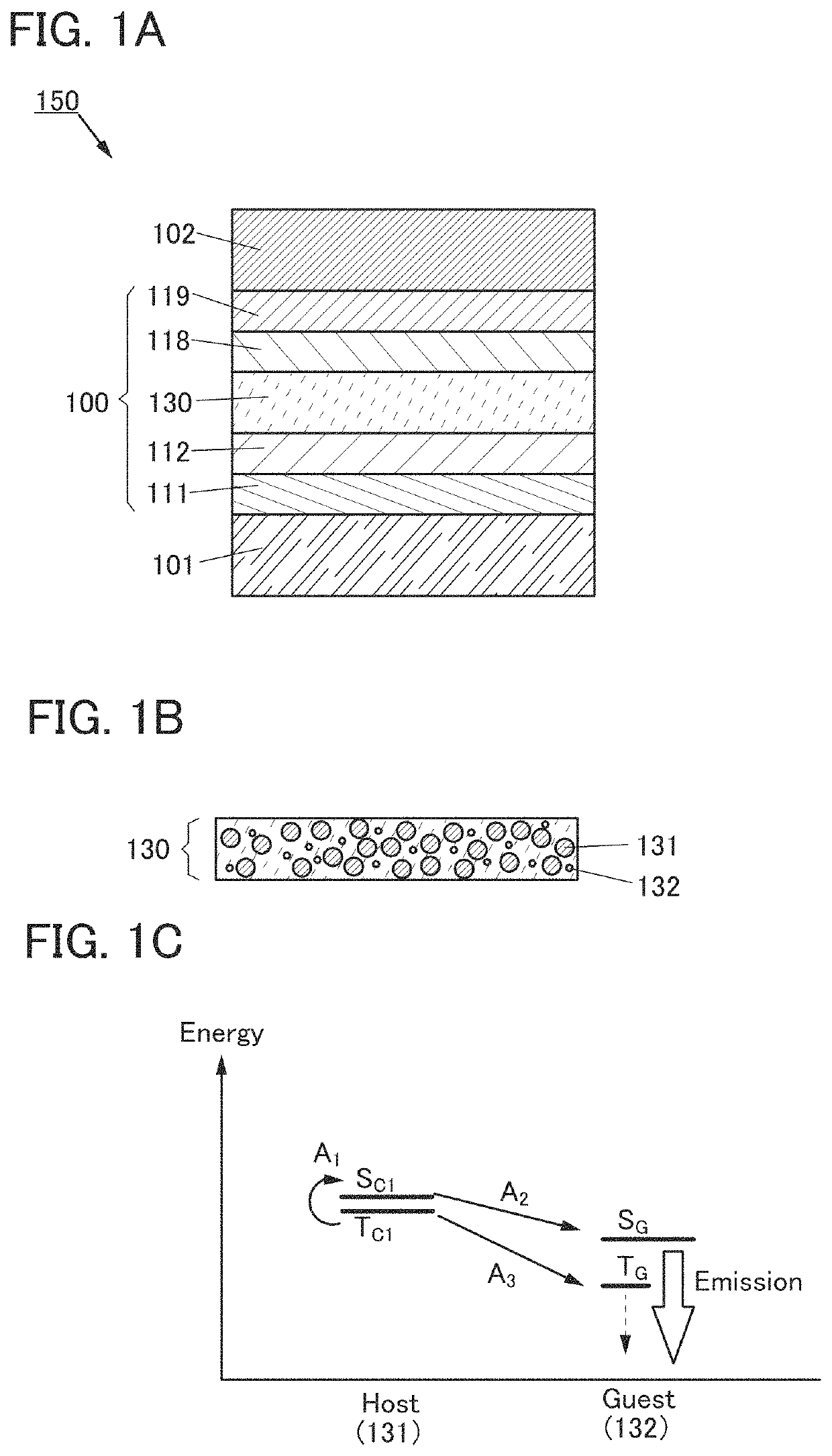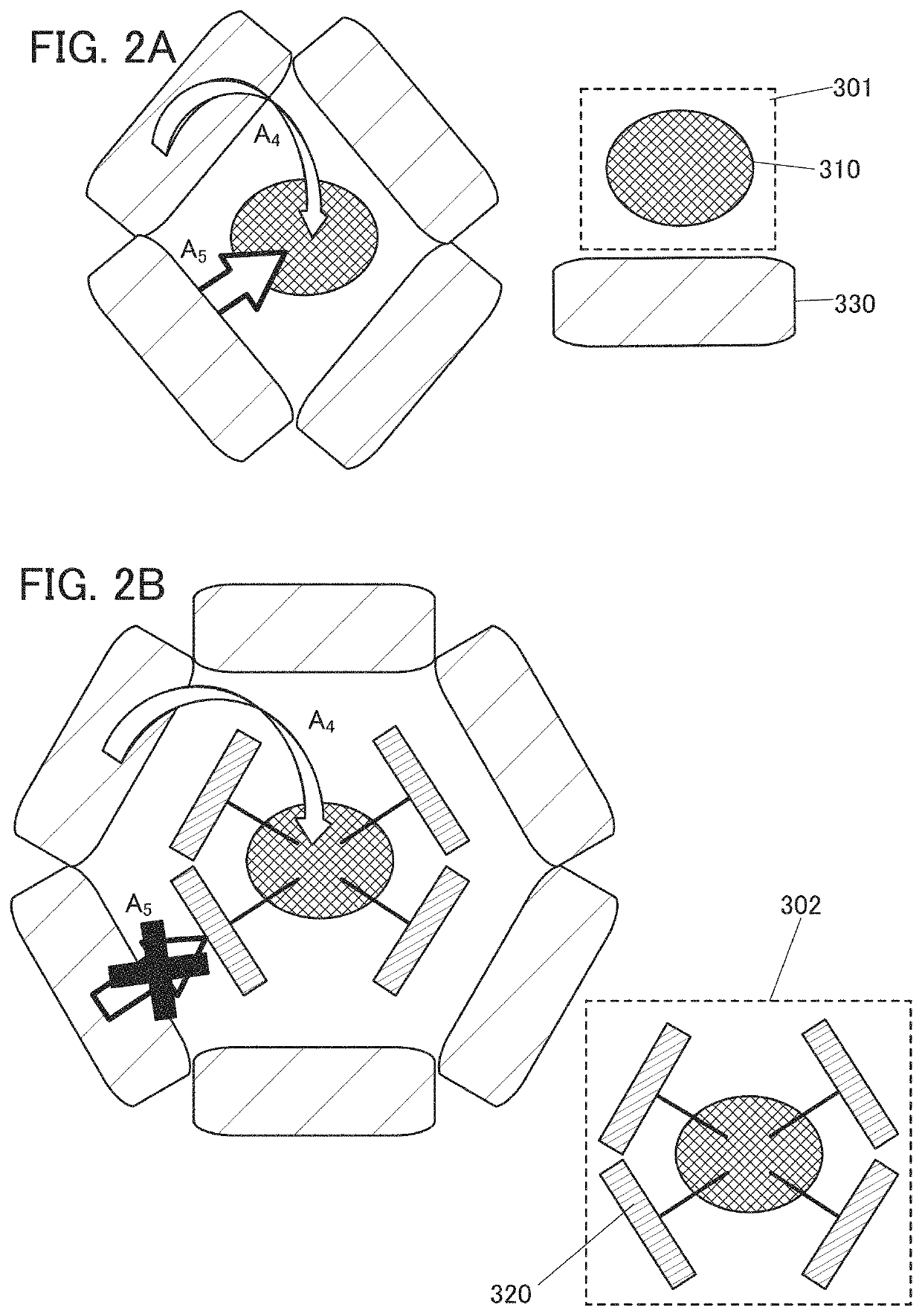Light-emitting element, display device, electronic device, organic compound, and lighting device
- Summary
- Abstract
- Description
- Claims
- Application Information
AI Technical Summary
Benefits of technology
Problems solved by technology
Method used
Image
Examples
embodiment 1
[0243]In this embodiment, a light-emitting element of one embodiment of the present invention will be described below with reference to FIG. 1 to FIG. 6.
[0244]First, the structure of the light-emitting element of one embodiment of the present invention will be described below with reference to FIG. 1.
[0245]FIG. 1(A) is a schematic cross-sectional view of a light-emitting element 150 of one embodiment of the present invention.
[0246]The light-emitting element 150 includes a pair of electrodes (an electrode 101 and an electrode 102) and an EL layer 100 provided between the pair of electrodes. The EL layer 100 includes at least a light-emitting layer 130.
[0247]The EL layer 100 illustrated in FIG. 1(A) includes functional layers such as a hole-injection layer 111, a hole-transport layer 112, an electron-transport layer 118, and an electron-injection layer 119, in addition to the light-emitting layer 130.
[0248]Note that in this embodiment, although description is given assuming that the e...
embodiment 2
[0477]In this embodiment, examples of a method for synthesizing an organic compound that can be favorably used for the light-emitting element of one embodiment of the present invention will be described giving the organic compounds represented by General Formulae (G1) and (G2) as an example.
[0478]The organic compound represented by General Formula (G1) shown above can be synthesized by a synthesis method using a variety of reactions. For example, the organic compound can be synthesized by Synthesis Schemes (S-1) and (S-2) shown below. A compound 1, an arylamine (compound 2), and an arylamine (compound 3) are coupled, whereby a diamine compound (compound 4) is obtained.
[0479]Next, the diamine compound (compound 4), halogenated aryl (compound 5), and halogenated aryl (compound 6) are coupled, whereby the organic compound represented by General Formula (G1) can be obtained.
[0480]In Synthesis Schemes (S-1) and (S-2) shown above, A represents a substituted or unsubstituted condensed arom...
embodiment 3
[0504]In this embodiment, a light-emitting element having a structure different from the structure of the light-emitting element described in Embodiment 1 will be described below with reference to FIG. 7. Note that in FIG. 7, a portion having a function similar to that of a portion denoted by a reference numeral shown in FIG. 1(A) is represented by the same hatch pattern and the reference numeral is omitted in some cases. In addition, common reference numerals are used for portions having similar functions, and a detailed description thereof is omitted in some cases.
Structure Example 2 of Light-Emitting Element
[0505]FIG. 7 is a schematic cross-sectional view of a light-emitting element 250.
[0506]The light-emitting element 250 illustrated in FIG. 7 includes a plurality of light-emitting units (a light-emitting unit 106 and a light-emitting unit 108) between a pair of electrodes (the electrode 101 and the electrode 102). Any one of the plurality of light-emitting units preferably has ...
PUM
| Property | Measurement | Unit |
|---|---|---|
| Volume | aaaaa | aaaaa |
| Fraction | aaaaa | aaaaa |
| Length | aaaaa | aaaaa |
Abstract
Description
Claims
Application Information
 Login to View More
Login to View More - R&D
- Intellectual Property
- Life Sciences
- Materials
- Tech Scout
- Unparalleled Data Quality
- Higher Quality Content
- 60% Fewer Hallucinations
Browse by: Latest US Patents, China's latest patents, Technical Efficacy Thesaurus, Application Domain, Technology Topic, Popular Technical Reports.
© 2025 PatSnap. All rights reserved.Legal|Privacy policy|Modern Slavery Act Transparency Statement|Sitemap|About US| Contact US: help@patsnap.com



